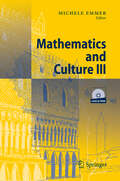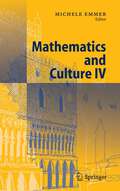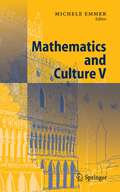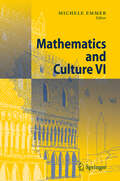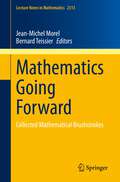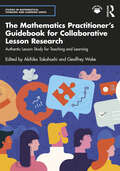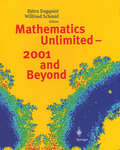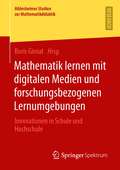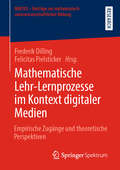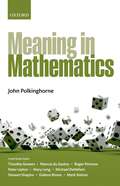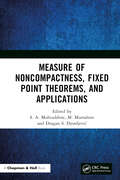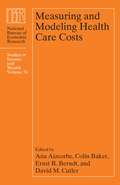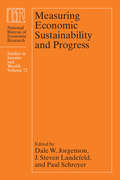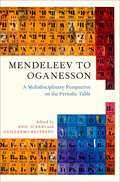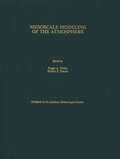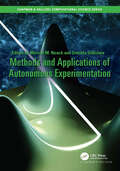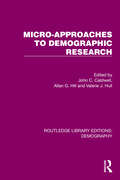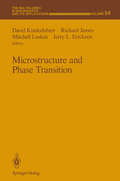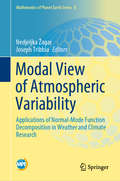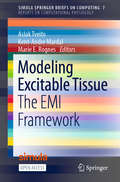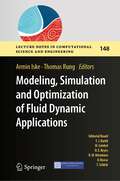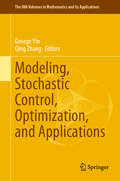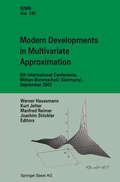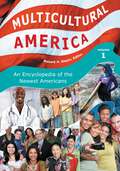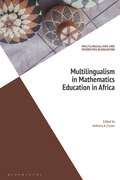- Table View
- List View
Mathematics and Culture III
This work contains the proceedings of the "Mathematics and Culture" conference held in Venice in March 2002. The conference aims to act as a bridge across the various aspects of human knowledge. While keeping mathematics as its core, it is aimed at anyone endowed with cultural curiosity and interests, whether within or (even more so) outside mathematics. This volume therefore covers music, cinema, art, theatre and literature, with topics ranging from Tibet to comics.
Mathematics and Culture IV
Gaudi’s dream which will be reached finalizing the construction of the "Sagrada Familia" in Barcelona, the victory of the Swiss sail boat "Alinghi", which won America’s Cup, films such as " A Beautiful Mind" and "Enigma", the theatrical play based on the life of Galois, the images of the Dutch graphic artist M. C. Escher, crypotography, comics. What all these topics have in common? Mathematics, of course. This book focuses on the important role of mathematics in culture. It shows how very complex links between mathematics and culture can be not only interesting and stimulating but also fun.
Mathematics and Culture V
“I mean the third”cried the old man taking up the geometry book. “Well, young lady…”and he bent over his daughter. The princess gazed with terror into her father's keen eyes. He, on his part, got angry – pushed away his chair, dragged it back with a cl- ter – trying all the while to control himself; then again he would break out and storm, and wish the whole thing to the devil. As ill-luck would have it, to-day again his daughter answered at random and wrongly. “What an idiot!”he exclaimed, flinging down the book. The he rose, walked up and down, came back and stroked his daughter's hair, sat down again, and began his explanation once more. “It does not do, princess, it does not do”, he said, seeing her rise to leave him with VII the book in her hand. “Mathematics is a noble science, and I do not want you to be just like all the silly young ladies one meets. Persevere and you will learn to like the work, and the dullness will be nocked out of your brain. ” These words were spoken by Prince Andrei Bolkonskij, who was talking to Princess Marja Bolokonskaja, his daughter. They are two of the protagonists of Lev Tolstoy’s War and Peace, finished in 1869.
Mathematics Going Forward: Collected Mathematical Brushstrokes (Lecture Notes in Mathematics #2313)
This volume is an original collection of articles by 44 leading mathematicians on the theme of the future of the discipline. The contributions range from musings on the future of specific fields, to analyses of the history of the discipline, to discussions of open problems and conjectures, including first solutions of unresolved problems. Interestingly, the topics do not cover all of mathematics, but only those deemed most worthy to reflect on for future generations. These topics encompass the most active parts of pure and applied mathematics, including algebraic geometry, probability, logic, optimization, finance, topology, partial differential equations, category theory, number theory, differential geometry, dynamical systems, artificial intelligence, theory of groups, mathematical physics and statistics.
The Mathematics Practitioner’s Guidebook for Collaborative Lesson Research: Authentic Lesson Study for Teaching and Learning (Studies in Mathematical Thinking and Learning Series)
This resource provides mathematics educators with tools for conducting Collaborative Lesson Research (CLR), a form of Lesson Study developed out of the original Japanese Lesson Study and intended to improve student and teacher learning. Renowned mathematics education researchers Akihiko Takahashi and Geoffrey Wake bring together educators across the US and UK with first-hand experience using CLR in their schools. Readers will learn the essentials for an impactful Lesson Study directly from the scholars who coined the term, and benefit from the dual perspectives of math education researchers and teachers who have used CLR when reflecting on their own classroom pedagogy. These contributors define CLR and provide examples of successful CLR using real-life case studies, as well as introducing pathways for getting started and practical suggestions for implementation into different school environments. Across these examples, readers will: understand the essence of Lesson Study, considered as CLR, and its important features be advised what participants in CLR should expect to do (observing research lessons, designing lessons, teaching research lessons, facilitating post-lesson discussion, etc.) and provide guidance and support with this enactment be advised on how to develop, embed, and sustain CLR communities preview potential outcomes over time from undertaking CLR Research lesson proposals and plans to support readers in understanding CLR are also included. Ideal for practicing teachers, teacher leaders, teacher educators, and professional developers involved in mathematics teaching, this book offers first-of-its-kind entry points for CLR. Its combination of theory and practice will empower educators to implement this increasingly popular vehicle for understanding students’ learning of mathematics.
Mathematics Unlimited - 2001 and Beyond
This is a book guaranteed to delight the reader. It not only depicts the state of mathematics at the end of the century, but is also full of remarkable insights into its future de- velopment as we enter a new millennium. True to its title, the book extends beyond the spectrum of mathematics to in- clude contributions from other related sciences. You will enjoy reading the many stimulating contributions and gain insights into the astounding progress of mathematics and the perspectives for its future. One of the editors, Björn Eng- quist, is a world-renowned researcher in computational sci- ence and engineering. The second editor, Wilfried Schmid, is a distinguished mathematician at Harvard University. Likewi- se the authors are all foremost mathematicians and scien- tists, and their biographies and photographs appear at the end of the book. Unique in both form and content, this is a "must-read" for every mathematician and scientist and, in particular, for graduates still choosing their specialty. Limited collector's edition - an exclusive and timeless work. This special, numbered edition will be available until June 1, 2000. Firm orders only.
Mathematik lernen mit digitalen Medien und forschungsbezogenen Lernumgebungen: Innovationen in Schule und Hochschule (Hildesheimer Studien zur Mathematikdidaktik)
Entdeckendes Lernen und digitale Medien in Schule und Hochschule stehen im Zentrum dieses Sammelbandes: Anhand konkret ausgearbeiteter Konzepte und Aufgabensammlungen wird vorgestellt, wie dynamische Geometriesysteme und Tabellenkalkulationen im Geometrieunterricht der Sekundarstufe ebenso eingesetzt werden können wie in universitären Seminaren. Forschungsbasiertes Lernen mit oder ohne digitale Medien wird an mathematischen Themen wie der Analysis und der Graphentheorie (von der Grundschule bis zur Universität) oder an gebietsübergreifenden Fallstudien (wie am Spiel „Lights out“) oder als allgemeines Konzept für Seminare zum Grundschullehramt veranschaulicht. Außerdem werden digitale Lern- und Prüfungsumgebungen für den fachwissenschaftlichen und fachdidaktischen Teil der mathematischen Lehramtsausbildung vorgestellt.
Mathematische Lehr-Lernprozesse im Kontext digitaler Medien: Empirische Zugänge und theoretische Perspektiven (MINTUS – Beiträge zur mathematisch-naturwissenschaftlichen Bildung)
Der vorliegenden Band zeichnet sich durch eine große Bandbreite an Zugängen zum Themenkomplex „Digitales im Mathematikunterricht“ aus; diese reicht von Theorieartikeln zur Fundierung des Einsatzes digitaler Werkzeuge und Medien in der Mathematikdidaktik, über Anwendungsperspektiven für die Mathematiklehrerinnen- und Mathematiklehrerausbildung, bis hin zu aussagekräftigen Praxisberichten aus der Schule. Das nun entstandene Werk ist Ausdruck einer lebendigen multiperspektivischen Auseinandersetzung mit dem Gegenstand der digitalen Bildung in der Mathematikdidaktik. Diese wird im vorliegenden Buch getragen von einer positiven Grundeinstellung zu den Möglichkeiten, die digitale Werkzeuge und Medien für den Mathematikunterricht entfalten können, werden aber in kritischer Abwägung wissenschaftlich betrachtet um auszuloten wann, wo und wie ein Einsatz einen fachinhaltlichen und fachdidaktischen Mehrwert entfalten kann.
Meaning in Mathematics
Is mathematics a highly sophisticated intellectual game in which the adepts display their skill by tackling invented problems, or are mathematicians engaged in acts of discovery as they explore an independent realm of mathematical reality? Why does this seemingly abstract discipline provide the key to unlocking the deep secrets of the physical universe? How one answers these questions will significantly influence metaphysical thinking about reality. This book is intended to fill a gap between popular 'wonders of mathematics' books and the technical writings of the philosophers of mathematics. The chapters are written by some of the world's finest mathematicians, mathematical physicists and philosophers of mathematics, each giving their perspective on this fascinating debate. Every chapter is followed by a short response from another member of the author team, reinforcing the main theme and raising further questions. Accessible to anyone interested in what mathematics really means, and useful for mathematicians and philosophers of science at all levels, Meaning in Mathematics offers deep new insights into a subject many people take for granted.
Measure of Noncompactness, Fixed Point Theorems, and Applications
The theory of the measure of noncompactness has proved its significance in various contexts, particularly in the study of fixed point theory, differential equations, functional equations, integral and integrodifferential equations, optimization, and others. This edited volume presents the recent developments in the theory of the measure of noncompactness and its applications in pure and applied mathematics. It discusses important topics such as measures of noncompactness in the space of regulated functions, application in nonlinear infinite systems of fractional differential equations, and coupled fixed point theorem.Key Highlights: Explains numerical solution of functional integral equation through coupled fixed point theorem, measure of noncompactness and iterative algorithm Showcases applications of the measure of noncompactness and Petryshyn’s fixed point theorem functional integral equations in Banach algebra Explores the existence of solutions of the implicit fractional integral equation via extension of the Darbo’s fixed point theorem Discusses best proximity point results using measure of noncompactness and its applications Includes solvability of some fractional differential equations in the holder space and their numerical treatment via measures of noncompactness This reference work is for scholars and academic researchers in pure and applied mathematics.
Measuring and Modeling Health Care Costs (National Bureau of Economic Research Studies in Income and Wealth #76)
Health care costs represent a nearly 18% of U.S. gross domestic product and 20% of government spending. While there is detailed information on where these health care dollars are spent, there is much less evidence on how this spending affects health. The research in Measuring and Modeling Health Care Costs seeks to connect our knowledge of expenditures with what we are able to measure of results, probing questions of methodology, changes in the pharmaceutical industry, and the shifting landscape of physician practice. The research in this volume investigates, for example, obesity’s effect on health care spending, the effect of generic pharmaceutical releases on the market, and the disparity between disease-based and population-based spending measures. This vast and varied volume applies a range of economic tools to the analysis of health care and health outcomes. Practical and descriptive, this new volume in the Studies in Income and Wealth series is full of insights relevant to health policy students and specialists alike.
Measuring Economic Sustainability and Progress (National Bureau of Economic Research Studies in Income and Wealth #72)
Since the Great Depression, researchers and statisticians have recognized the need for more extensive methods for measuring economic growth and sustainability. The recent recession renewed commitments to closing long-standing gaps in economic measurement, including those related to sustainability and well-being. The latest in the NBER’s influential Studies in Income and Wealth series, which has played a key role in the development of national account statistics in the United States and other nations, this volume explores collaborative solutions between academics, policy researchers, and official statisticians to some of today’s most important economic measurement challenges. Contributors to this volume extend past research on the integration and extension of national accounts to establish an even more comprehensive understanding of the distribution of economic growth and its impact on well-being, including health, human capital, and the environment. The research contributions assess, among other topics, specific conceptual and empirical proposals for extending national accounts.
Mendeleev to Oganesson: A Multidisciplinary Perspective on the Periodic Table
Since 1969, the international chemistry community has only held conferences on the topic of the Periodic Table three times, and the 2012 conference in Cusco, Peru was the first in almost a decade. The conference was highly interdisciplinary, featuring papers on geology, physics, mathematical and theoretical chemistry, the history and philosophy of chemistry, and chemical education, from the most reputable Periodic Table scholars across the world. Eric Scerri and Guillermo Restrepo have collected fifteen of the strongest papers presented at this conference, from the most notable Periodic Table scholars. The collected volume will contain pieces on chemistry, philosophy of science, applied mathematics, and science education.
Mesoscale Modeling of the Atmosphere (Meteorological Monographs)
This book provides an overview of several components of mesoscale modeling: boundary conditions, subgrid-scale parameterization, moisture processes, and radiation. Also included are mesoscale model comparisons using data from the U.S. Army's Project WIND (Winds in Non-uniform Domains).
Methods and Applications of Autonomous Experimentation (Chapman & Hall/CRC Computational Science)
Autonomous Experimentation is poised to revolutionize scientific experiments at advanced experimental facilities. Whereas previously, human experimenters were burdened with the laborious task of overseeing each measurement, recent advances in mathematics, machine learning and algorithms have alleviated this burden by enabling automated and intelligent decision-making, minimizing the need for human interference. Illustrating theoretical foundations and incorporating practitioners’ first-hand experiences, this book is a practical guide to successful Autonomous Experimentation. Despite the field’s growing potential, there exists numerous myths and misconceptions surrounding Autonomous Experimentation. Combining insights from theorists, machine-learning engineers and applied scientists, this book aims to lay the foundation for future research and widespread adoption within the scientific community. This book is particularly useful for members of the scientific community looking to improve their research methods but also contains additional insights for students and industry professionals interested in the future of the field.
Micro-Approaches to Demographic Research (Routledge Library Editions: Demography #3)
Originally published in 1988, this collection of essays was the first attempt by population scientists to incorporate some of the methods and materials of anthropologists into their work. The essays bridge the gap in the conceptualisation and organisation of field research by 2 sets of social scientists – demographers and social anthropologists – who share an interest in the explanation of particular patterns of population composition and change.
Microstructure and Phase Transition (The IMA Volumes in Mathematics and its Applications #54)
This IMA Volume in Mathematics and its Applications MICROSTRUCTURE AND PHASE TRANSITION is based on the proceedings of a workshop which was an integral part of the 1990-91 IMA program on "Phase Transitions and Free Boundaries." We thank R. Fosdick, M.E. Gurtin, W.-M. Ni and L.A. Peletier for organizing the year-long program and, especially, D. Kinderlehrer, R. James, M. Luskin and J. Ericksen for organizing the meeting and editing these proceedings. We also take this opportunity to thank those agencies whose financial support made the workshop possible: the Army Research Office, and the National Science Foun dation. A vner Friedman Willard Miller. Jr. PREFACE Much of our traditional knowledge of materials and processes is achievf'd by observa tion and analysis of small departures from equilibrium. Many materials, especially modern alloys, ceramics, and their composites, experience not only larger but more dramatic changes, such as the occurrence of phase transitions and t.he creation of defect structures, when viewed at the microscopic scale. How is this observed, how can it be interpreted, and how does it influence macroscopic behavior? These are the principle concerns of this volume, which constitutes the proceedings of an IMA workshop dedicated to these issues.
Modal View of Atmospheric Variability: Applications of Normal-Mode Function Decomposition in Weather and Climate Research (Mathematics of Planet Earth #8)
This book reviews the theory and applications of the normal-mode functions in numerical weather prediction and weather and climate dynamics. The normal-mode functions, the eigensolutions of the linearized primitive equations describing the evolution of atmospheric winds and mass variables, have been used for a long time. They have played an important role in the development of data assimilation schemes and the initialization of numerical weather prediction models. Chapters also present how the normal modes can be applied to many theoretical and numerical problems in the atmospheric sciences, such as equatorial wave dynamics, baroclinic instability, energy transfers, and predictability across scales.
Modeling Excitable Tissue: The EMI Framework (Simula SpringerBriefs on Computing #7)
This open access volume presents a novel computational framework for understanding how collections of excitable cells work. The key approach in the text is to model excitable tissue by representing the individual cells constituting the tissue. This is in stark contrast to the common approach where homogenization is used to develop models where the cells are not explicitly present. The approach allows for very detailed analysis of small collections of excitable cells, but computational challenges limit the applicability in the presence of large collections of cells.
Modeling, Simulation and Optimization of Fluid Dynamic Applications (Lecture Notes in Computational Science and Engineering #148)
This book describes recent collaborations combining the expertise of applied mathematicians, engineers and geophysicists within a research training group (RTG) on "Modeling, Simulation and Optimization of Fluid Dynamic Applications”, funded by the Deutsche Forschungsgemeinschaft (DFG). The focus is on mathematical modeling, adaptive discretization, approximation strategies and shape optimization with PDEs. The balanced research program is based on the guiding principle that mathematics drives applications and is inspired by applications. With this leitmotif the RTG advances research in Modeling, Simulation and Optimization by an interdisciplinary approach, i.e., to stimulate fundamental education and research by highly complex applications and at the simultaneously transfer tailored mathematical methods to applied sciences. The reported research involves nine projects and addresses challenging fluid dynamic problems inspired by applied sciences, such as climate research & meteorology, energy, aerospace & marine engineering, or medicine. More fundamental research concerning analysis, approximation and numerics is also covered.The material represents a successful attempt to exchange research paradigms between different disciplines and thus displays a modern approach to basic research into scientifically and societally relevant contemporary problems.
Modeling, Stochastic Control, Optimization, and Applications (The IMA Volumes in Mathematics and its Applications #164)
This volume collects papers, based on invited talks given at the IMA workshop in Modeling, Stochastic Control, Optimization, and Related Applications, held at the Institute for Mathematics and Its Applications, University of Minnesota, during May and June, 2018. There were four week-long workshops during the conference. They are (1) stochastic control, computation methods, and applications, (2) queueing theory and networked systems, (3) ecological and biological applications, and (4) finance and economics applications. For broader impacts, researchers from different fields covering both theoretically oriented and application intensive areas were invited to participate in the conference. It brought together researchers from multi-disciplinary communities in applied mathematics, applied probability, engineering, biology, ecology, and networked science, to review, and substantially update most recent progress. As an archive, this volume presents some of the highlights of the workshops, and collect papers covering a broad range of topics.
Modern Developments in Multivariate Approximation: 5th International Conference, Witten-Bommerholz (Germany), September 2002 (International Series of Numerical Mathematics #145)
This volume contains a selection of eighteen peer-reviewed articles that were presented at the 5th International Conference on Multivariate Approximation, held in Witten-Bommerholz in September 2002. The contributions cover recent developments of constructive approximation on manifolds, approximation by splines and kernels, subdivision techniques and wavelet methods. The main topics are:- applications of multivariate approximation in finance- approximation and stable reconstruction of images, data reduction- multivariate splines for Lagrange interpolation and quasi-interpolation- radial basis functions- spherical point sets- refinable function vectors and non-stationary subdivision- applications of adaptive wavelet methods- blending functions and cubature formulae- singularities of harmonic functionsThe book provides an overview of state-of-the-art developments in a highly relevant field of applied mathematics, with many links to computer science and geophysics.
Multicultural America [4 volumes]: An Encyclopedia of the Newest Americans [4 volumes]
This encyclopedia contains 50 thorough profiles of the most numerically significant immigrant groups now making their homes in the United States, telling the story of our newest immigrants and introducing them to their fellow Americans.One of the main reasons the United States has evolved so quickly and radically in the last 100 years is the large number of ethnically diverse immigrants that have become part of its population. People from every area of the world have come to America in an effort to realize their dreams of more opportunity and better lives, either for themselves or for their children.This book provides a fascinating picture of the lives of immigrants from 50 countries who have contributed substantially to the diversity of the United States, exploring all aspects of the immigrants' lives in the old world as well as the new. Each essay explains why these people have come to the United States, how they have adjusted to and integrated into American society, and what portends for their future. Accounts of the experiences of the second generation and the effects of relations between the United States and the sending country round out these unusually rich and demographically detailed portraits.
Multilingualism in Mathematics Education in Africa (Multilingualisms and Diversities in Education)
This book brings together the first book collection of African research in mathematics education in multilingual societies andchronicles current research in different linguistic contexts across the African continent, (including Algeria, Namibia, Malawi, Morocco, Rwanda, South Africa) on issues of multilingualism in mathematics education, but more importantly, it foregrounds pertinent issues for future research. With many of the authors building on earlier path-breaking African research, the book is a unique contribution of careful thinking through how linguistic diversity and multilingualism manifest in ways that differ from one geopolitical context to another. This volume is an important contribution to the growing recognition of multilingualism as the global 'linguistic dispensation' in mathematics education. It is an invitation to how we might (as an international community where more and more multilingualism is the norm rather than an exception) pay more attention to the multilingual agency and capabilities of both students and teachers in order to better harness the epistemic potential of multiple languages in contexts of language diversity in mathematics education.
